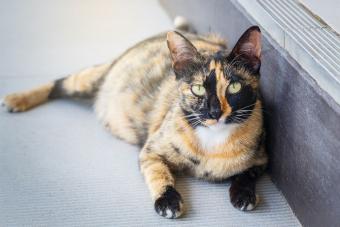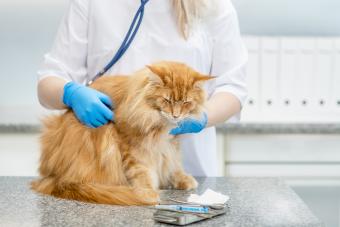
Cats are notoriously picky eaters, but if your feline friend is not eating anything at all, this is a very serious condition that needs to be monitored closely. The cause could be as simple as feeling bored with the same diet or as serious as a bowel obstruction. When a cat turns up their nose at more than two meals, it's time to consider possible health problems. Learn how to prevent further complications by understanding the top seven reasons your cat may be inappetent.
1. Food-Related Issues
There are several possible concerns that could be directly related to your cat's food.
Food is Old or Stale
Cats are much like humans in that they enjoy food that tastes good, so they may refuse to eat food that is old or stale. Your cat's diet can become stale more quickly when it is stored in a warm or humid environment than food kept in a cool, dry area. If you live in a humid climate, store feline kibble in a cool area or buy smaller amounts of food at a time to avoid spoilage.
Food Is Too Cold
Cats prefer food that is warm or, at the very least, room temperature. If your cat is refusing canned cat food that has been kept in the refrigerator, allow it to come to room temperature or mix in some warm water before offering it to your pet. This technique seems to work, as it also creates the delicious gravy that so many picky felines prefer.
Boredom With Diet
Would you enjoy eating the same thing day in and day out? Just as humans can become bored with food, your cat may not like eating the same thing at every meal. If your cat isn't interested in their normal diet, try tempting their palate by offering a few different foods. Be aware that abruptly changing your cat's diet could result in gastrointestinal upset, such as soft stool.
Food Bowl Problems
Cats can avoid their food if there is a problem with the bowl. Some common problems that can cause a cat to avoid eating include an allergy to the material the bowl is made from (in most cases, plastic), receiving an electric charge from a metal bowl, or dirty bowls. Try a different dish material to determine if this is the cause of your cat's inappetence.

Another Food Source
If your kitty is allowed outside, they may have found another food source. Cats can eat a variety of wildlife, such as birds, mice, moles, voles, baby rabbits, grasshoppers, and even snakes. It all depends on what is available where you live and how adventurous your pet is. If you live in a suburban area, your cat may also eat at a neighbor's home, especially if they feed their pet outdoors. While you have little control over this, it may be the reason your pet refuses food at home.
2. Dental/Oral Discomfort
Dental or oral problems can cause a cat to stop eating, and they can appear to surface virtually overnight. Any of the following dental problems could result in your cat avoiding food.
- Abscessed teeth
- Oral wounds
- Fractured teeth
- Lesions on the lips or gums
- Inflamed gums, also known as gingivitis
- Oral cancer
Although you can attempt to look in your cat's mouth to identify if this is the root cause, it can be challenging to do at home. Your veterinarian can examine your cat's mouth to determine if they have any oral concerns, and may recommend a dental cleaning with possible extractions.
3. Medical Conditions
When a cat refuses to eat and it seems unrelated to food or a dental problem, there can be many underlying medical reasons for avoiding food. Some of the most common feline illnesses that can present with inappetence include the following.
- Pancreatitis
- Kidney failure
- Liver disease
- Diabetes
- Hyperthyroidism
- Cancer
Typically, other signs will also accompany the refusal to eat, such as vomiting, weight loss, diarrhea, increased thirst, and increased urination. An exam with your vet is the first step in diagnosing then treating these conditions.
4. Intestinal Blockage
A blockage within the intestinal tract -- whether in the upper intestine, the stomach, or in the colon -- could prevent a cat from wanting to eat. Obstructions occur when a cat eats something that they shouldn't, like a hair tie or string. They prevent intestinal contents from moving, which can make a cat nauseous and stop eating. Depending on where and what the foreign material is, surgery might be necessary.
Alternatively, a cat could become blocked with its own stool. Constipation is not uncommon in cats, although it can be a symptom of some other underlying disease. You could try an oral remedy to get things moving, but severely constipated cats occasionally require in-hospital enemas or deobstipation (a procedure to manually remove feces, or to use a continuous nasogastric infusion of a polyethylene glycol solution to produce the same effect). Never attempt to give your cat an enema at home, as many human enemas are toxic to pets.
5. Anxiety
If a cat is stressed, depressed, or fearful, they may be reluctant to eat. Consider whether there are been any changes in your household -- have you recently moved? Have you lost a pet? Have you gained a new pet? Have you introduced any other new elements? Cats are incredibly sensitive to their environments, so they may be too upset to eat.
Try feeding your cat in a separate, quiet area away from traffic or other animals. You can use calming aids, such as pheromone sprays, or talk to your vet about other temporary or permanent anti-anxiety solutions to help your cat adjust.

6. Upper Respiratory Infection
When cats get an upper respiratory infection (URI), they usually sneeze, develop watery eyes, and become congested. Inflammation of the tissues in the nose and throat can make swallowing food uncomfortable, plus their inability to smell through their nose means they might not have an appetite. With a course of appropriate antibiotics, cats can regain their normal appetite and energy.
7. Fever
Anyone who has had a fever can tell you that the last thing on their mind during that period was eating. Cats can develop a fever for numerous reasons, including an abscess, pyometra, other bacterial infection, infectious feline-specific virus, or immune-mediated disease. Regardless of the source, anything above the normal temperature range for cats, which is 100.4 to 102.5 degrees Fahrenheit, can cause them to stop eating. You can try to take your cat's temperature at home, but a trip to the vet is warranted to treat a fever.
Complications Secondary to Inappetence
When a cat hasn't eaten in 24 hours or longer, there are adverse conditions that can develop as a result. The most common is hepatic lipidosis, also known as fatty liver. With this condition, a cat's body begins to break down fat because there is no food available, which can lead to liver dysfunction. Overweight cats are more susceptible to developing hepatic lipidosis. Cats can recover from this complication, but treatment typically requires aggressive fluid therapy and supportive care. Sometimes a feeding tube is necessary. The best way to protect your cat from developing fatty liver is to prevent them from going too long without eating in the first place.
Dehydration is a serious concern if a cat is not eating or drinking. Kittens in particular are at high risk for becoming dehydrated due to their small size, so owners should seek urgent care if a kitten has not eaten in 12 hours. Cat owners must also be aware of hypoglycemia, or low blood sugar, if a cat or kitten has stopped eating. Signs of hypoglycemia include weakness, collapse, or seizures.
Techniques to Encourage Your Cat to Eat
If you're not able to get to the vet right away or have an appointment scheduled for tomorrow morning, there are a few tricks you can use in the interim to promote eating.

- Hand-feed. If a cat is stressed or not feeling 100 percent, they may need a little coaxing to eat. Try bringing your cat to a quiet area and offering them food by hand.
- Try wet food. A cat that typically eats dry food might be tempted to eat if you offer them some tasty canned food.
- Offer meat baby food. A tried-and-true trick used in the veterinary setting is offering meat baby foods. There are usually several available flavors, such as chicken, beef, or turkey, but be sure they don't contain onion or garlic, which are toxic to cats.
- Create a steam room. If your cat is not eating because of a suspected upper respiratory infection, you can try providing them with some relief with steam. Bring your cat into the bathroom as you take a hot shower to help unclog their sinuses.
Common Reasons Cats Stop Eating
A cat may stop eating for a variety of reasons. If your cat has not eaten for 24 hours or is exhibiting lethargy, vomiting, fever, upper respiratory signs, or oral discomfort in addition to not eating, call your vet for guidance. If left untreated, inappetence can lead to severe complications or even death.







